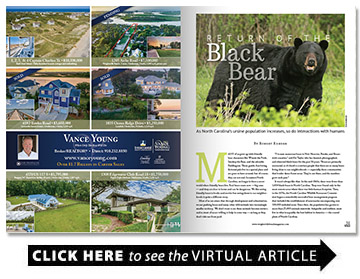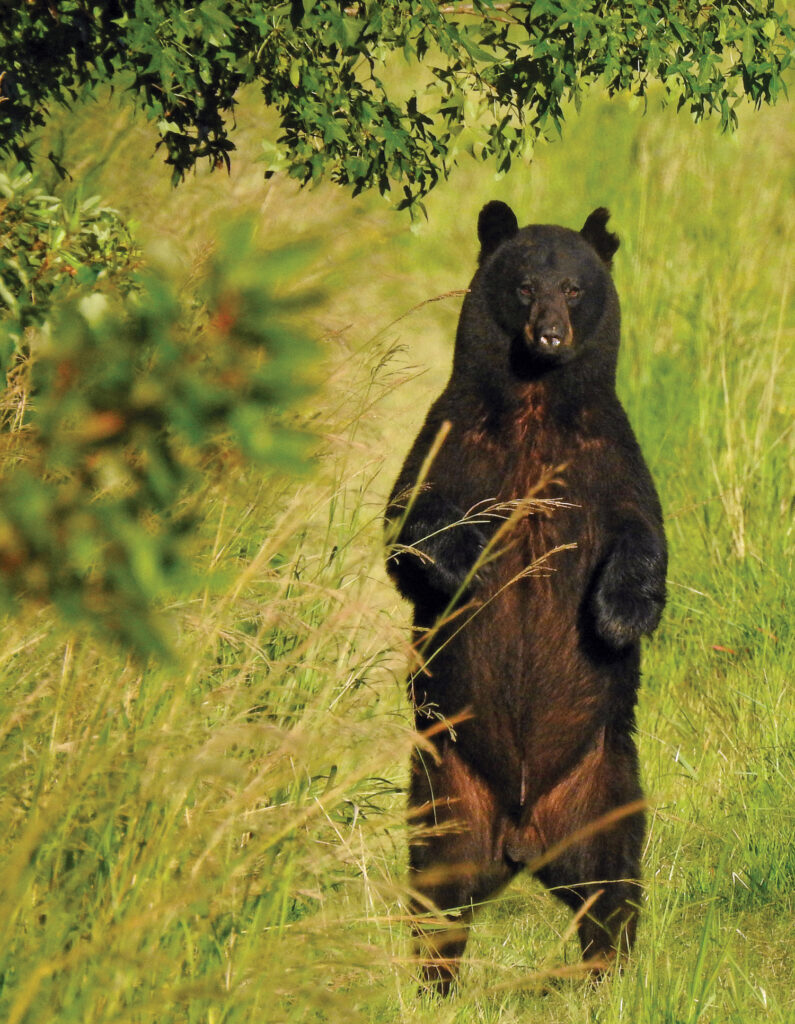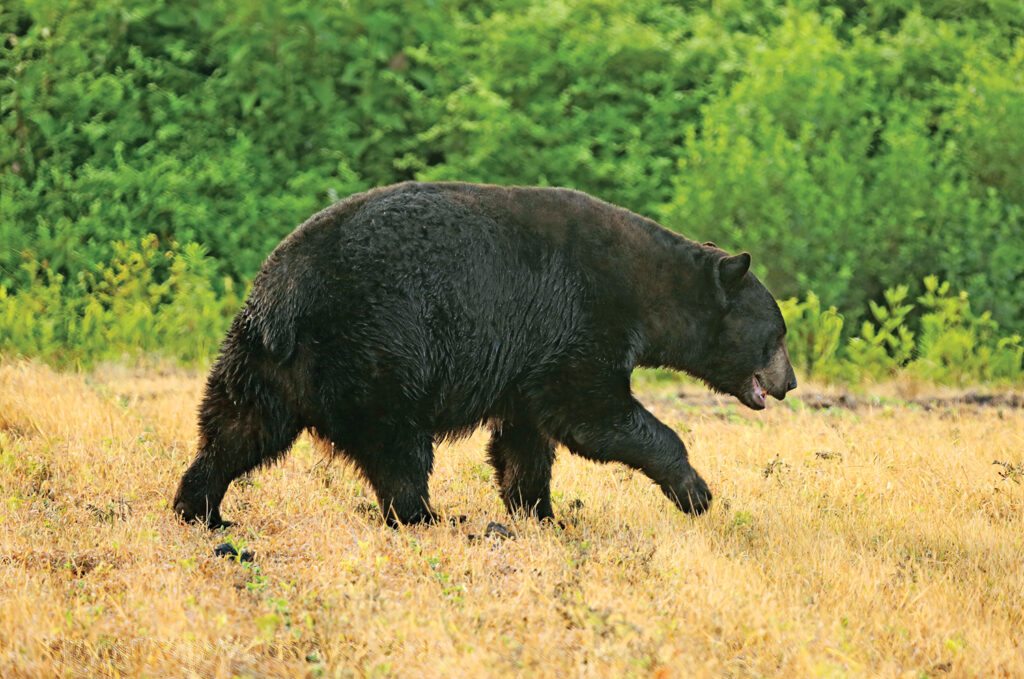Return of the Black Bear
As North Carolina’s ursine population increases, so do interactions with humans
BY Robert Rehder

Many of us grew up with friendly bear characters like Winnie the Pooh, Smokey the Bear, and the adorable Paddington. Those gentle, fun-loving fictional pals live in a special place and are great to have around, but of course, they are not real. In eastern North Carolina, no longer is there a secret world where friendly bears live. Real bears roam now — big ones — and they are close to home and can be dangerous. We like seeing friendly bears in books and movies but seeing them in our neighborhoods is quite a different story.
Most of us are aware that through development and urbanization, we are pushing bears and many other wild animals into increasingly smaller territory. We don’t want to see these animals become extinct, and so most of us are willing to help in some way — as long as they don’t visit our front yard.
“I’ve seen numerous bears in New Hanover, Pender, and Brunswick counties,” said Kit Taylor who has hunted, photographed, and observed black bears for the past 50 years. “Bears are primarily nocturnal, so it’s hard to convince people that there are so many bears living close to our neighborhoods — especially those communities that border dense forest areas. They’re out there, and the numbers grow each year.”
It wasn’t always like that. In the mid-1960s, there were fewer than 1,000 black bears in North Carolina. They were found only in the most remote areas where there was little human footprint. Then, in the 1970s, the North Carolina Wildlife Resources Commission began a remarkably successful bear management program that included the establishment of sanctuaries encompassing over 500,000 secluded acres. Since then, the population has grown to more than 25,000 animals statewide. Adaptable and resilient, most live in what is arguably the best habitat in America — the coastal plain of North Carolina.
In fact, the largest black bears in the world live in coastal North Carolina. The state record is an 880-pound bruiser taken in Craven County. Closer to home, Pender County grows some giants too. Ken Spell, hunting on the Black River, 26 miles from Wilmington, recently took a 720-pounder.
Black bears flourish in large expanses of uninhabited swamps, hardwoods and pocosins. For that ecosystem, look no farther than eastern North Carolina where three of the darkest, deepest most formidable swamps in all the South lie along our coast: the Green Swamp, the Great Dismal Swamp and Angola.
Virtually untouched by development, those swamps are home to four species of poisonous snakes, ticks and spiders by the millions, mosquitoes (about as big as hummingbirds), panthers, wild boars and alligators. It’s no place for humans, but no problem for bears because they can outrun, out-climb, out-swim, out-dig and out-fight everything in the forest. Bears are omnivores, and they happily eat anything that blooms, crawls, growls, squeaks or peeps including grasses, roots, berries, insects, fish, and animals — dead or alive. A wildlife biologist could not have designed a better home for bears than eastern North Carolina, and as a result populations are increasing each year.
While bear numbers are on the rise, so are human numbers, especially on the East Coast near historical bear territory. With human expansion comes urban development, and much of that development is ever closer to rural bear range. As a result, bears are feeling the pinch and beginning to roam beyond their traditional environment. The natural rule of cause and effect is evident — bears and people are now meeting each other with alarming frequency.
Colleen Olfenbuttel, the North Carolina Wildlife Resources Commission black bear biologist, offers advice about how to coexist with black bears.
“Most bears that wander into a residential area will quickly retreat to their natural habitat, particularly if no food source is around. Bears have adapted to living near people; now it’s up to us to adapt to living near bears,” said Olfenbuttel.
As a result of human/bear interaction, many stories have emerged. One of those tales is about a particularly large bear that lived in the Bear Garden section of the 48,000-acre Holly Shelter Game Land in Pender County but had begun to roam into bordering tracts of private land.
One of those tracts is owned by the Godwin family and contains a mix of hardwood, cypress swamp, pine plantation and open fields along Ashe’s Creek. Bordered by Holly Shelter and adjacent to the 24,000-acre Angola Bay Swamp, the property offers a unique area for black bears looking for new territory.
Bear sightings were rare on the Godwin tract, until one fall day when deer hunters came across excoriated logs and enormous paw prints on a section of disturbed forest floor near the Holly Shelter border. Though they didn’t see it that day, they knew a bear of phenomenal size had been there searching among the destroyed logs for ants and larvae with its powerful, needle-sharp claws.
While deer hunting on a crisp, December morning later that year, through an open forest glade, they finally saw the bear. “At first, we thought it was a big, charred stump that remained after last year’s controlled burn,” said Ashton Godwin. “Then abruptly the stump stood upright — an enormous, towering black bear — a very chilling sight! Having scented us, he turned with amazing speed, growling, slashing, and finally disappearing headlong into a jungle of thick canebrake.”
The hunt was on and late that afternoon after a long chase and stalk, Godwin finally had a clear shot.
“It was all we could do to get the bear on our scales which only went to 500 pounds. It immediately maxed out the scale, and we estimated the weight at close to 600 pounds, “said Godwin.
It’s one thing if you meet a bear while hunting, but what happens if you come upon one otherwise — and at close range? Unless provoked, a bear will usually run rather than fight. However, if threatened, cornered, or wounded, especially if it’s a female with cubs, it can be a completely different and fatal story. They can repeatedly attack with raging fury.
If you meet one, experts say back away slowly and sideways which is non-threatening to bears; make lots of noise and get to a safe distance. Don’t play dead, and never approach, challenge, or try to feed a bear. A mature bear can run 35 miles per hour uphill and downhill, climb a tree faster than a bobcat, bite through thick metal, and swat with bone-shattering force. The good news is bears are usually shy by nature, but don’t depend on that.
In September 2021, while having a picnic lunch at the Folk Art Center on the Blue Ridge Parkway, a couple was repeatedly attacked by a bear. They retreated to their car and drove to Mission Hospital where both were treated and released. They were lucky. Patrick Madura and Brenda Ann Bradley were not so fortunate. Madura was mauled and killed by a black bear in 2020 and Bradley in 2010 — both in North Carolina’s Great Smoky Mountains National Park.
North Carolina Wildlife Resources Commission programs inform the public about black bear interaction and help manage levels of human-bear conflict through educational programs.
However, it’s always best to remember that bears are dangerous wild animals, and their behavior can be unpredictable.
Large numbers of black bear and other wildlife annually draw photographers to eastern North Carolina. Snow Hill native and professional wildlife photographer Neil Jernigan is one of those who routinely photographs giant black bears — some within 50 feet! He tells of one winter day he won’t soon forget: “I was observing a field that was thick with plump, sprouted, winter wheat adjacent to a wildlife refuge. It was a bitter cold, windy day, and I had hoped to photograph bears but hadn’t seen any. The field was trampled in several places, so I knew bears must be using it at some point, so I waited,” said Jernigan.
“Late in the afternoon, finally I photographed a bear coming out of the refuge and feeding in the wheat. Bears are usually solitary and not sociable, so I was happy to see the one and was shocked and surprised when over the next hour almost 30 bears streamed out of the refuge into that one field. Drawn to the abundant wheat, they ate, they rolled, they chased and played, and they slept — it was quite an evening.”
Bears are beautiful, wild, adaptive, amazing animals. Wildlife refuges and remote areas with little human footprint will always be the most important habitat for them. They are extremely adaptable, and peaceful coexistence in the urban interface will continue if wildlife management is supported in North Carolina.
The N.C. wildlife resources commission offers this advice as black bear sightings and interactions increase:
Never feed or approach a bear. Intentionally feeding bears or allowing them to find anything that smells or tastes like food teaches them to approach homes and people to look for more. Bears will defend themselves if a person gets too close, so don’t risk your safety and theirs.
Secure food, garbage and recycling. [Black bears are smart and have been caught on film opening car, house and garage doors.] Food and food odors attract bears, so don’t reward them with easily available food or garbage. Store bags of trash inside cans in a garage, shed or other secure area, or use trash containers with a secure latching system or that are bear resistant. Place trash outside as late as possible on the morning of trash pick-up, not the night before.
Remove bird feeders when bears are active. Birdseed, other grains and hummingbird feeders have high calorie content making them very attractive to bears.
Feed pets indoors when possible. If you must feed pets outside, feed in single portions and remove food and bowls after feeding. Store pet food where bears can’t see or smell it.
Clean grills after each use and make sure that all grease, fat and food particles are removed, including drip trays. Store clean grills and smokers in a secure area, like a garage or shed.
If you see bears in the area or evidence of bear activity, tell your neighbors and share information about how to avoid bear conflicts.


